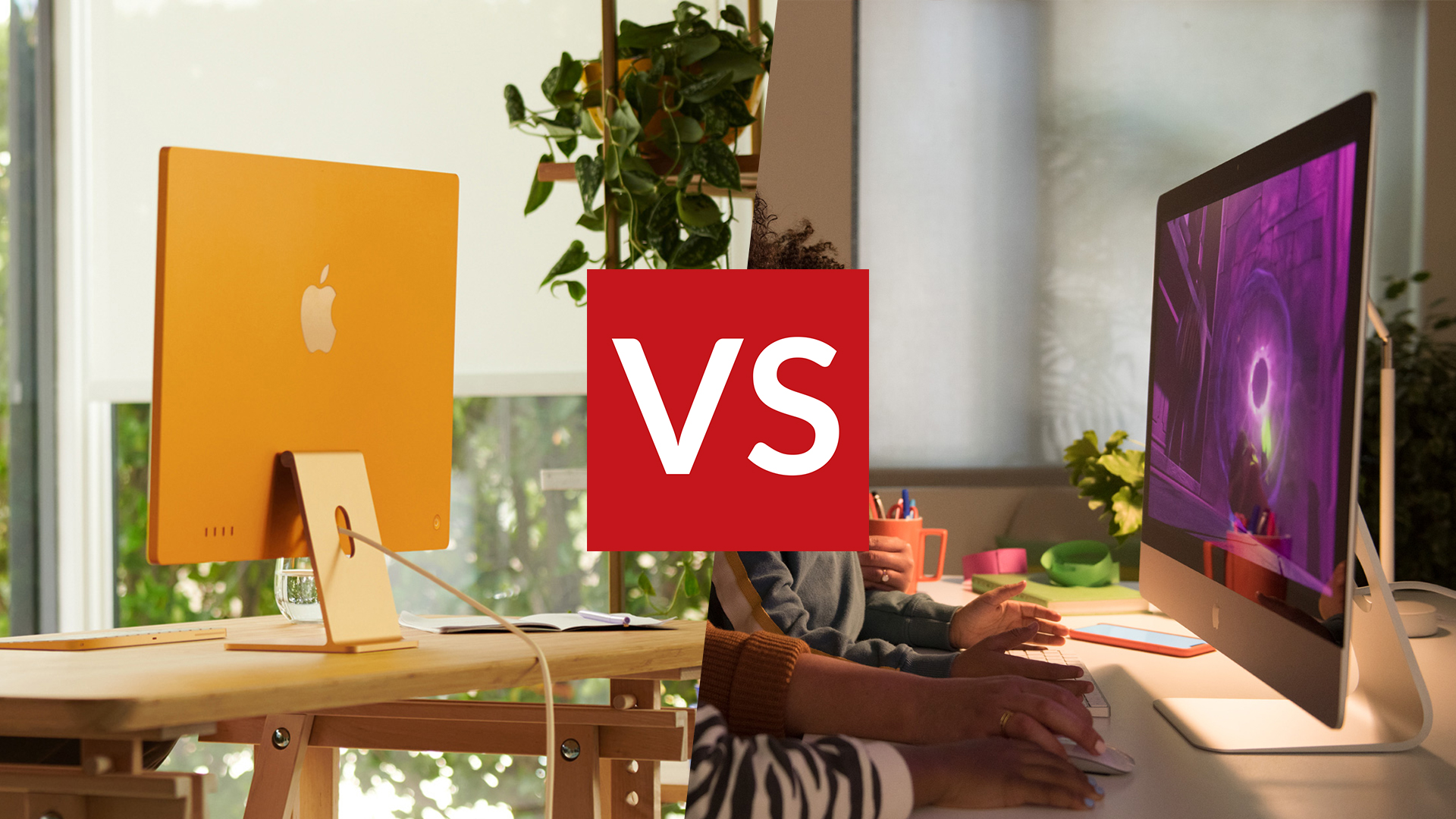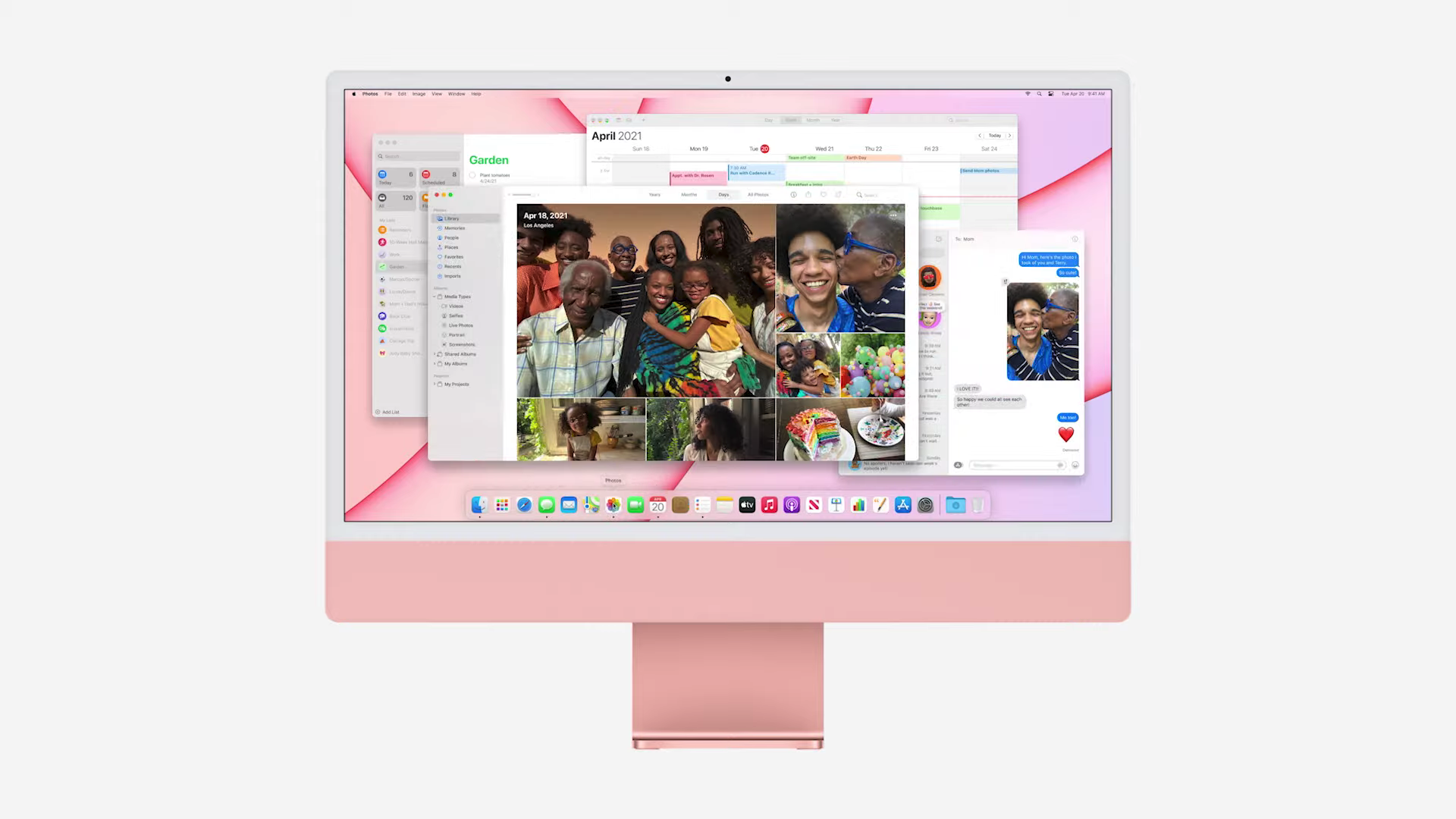

If you're looking for a new Apple all-in-one, you might looking at the iMac 24-inch (2021) vs iMac 27-inch (2020) and wondering exactly what the differences are – the design change is clear enough, but there are lots of subtle distinctions between them that aren't so obvious to understand.
In fact, there's barely a single spec that the iMac 24-inch (2021) and iMac 27-inch (2020) do share, and even when they appear to be the same, there's some little difference to the execution.
We'll take you through all the key information about these two desktops, so you can work out whether Apple's ultra-slim new 24-inch iMac will work for you, or whether the extra flexibility of the 27-inch model is what you need.
iMac 24-inch (M1, 2021) vs iMac 27-inch (2020): Price & release date
The iMac 24-inch will be available to pre-order on April 30th 2021, and is due for release in the second half of May 2021, which is a little vague, but that's all Apple is saying at the time of writing.
The iMac 24-inch starts from £1,249/$1,299/AU$1,899, which gets you an Apple M1 chip with 8-core processor and 7-core GPU, and 8GB of RAM, plus 256GB of SSD storage.
If you step up to the more expensive £1,449/$1,499/AU$2,199 model, you get some more ports (as we'll cover later in this guide) and an 8-core GPU, but no other spec improvements. There's not much configuring you can do here – you can opt for 16GB of RAM instead, or up to 2TB of storage, but that's it.
The current version of the iMac 27-inch was updated in August 2020.
Sign up to the T3 newsletter for smarter living straight to your inbox
Get all the latest news, reviews, deals and buying guides on gorgeous tech, home and active products from the T3 experts
The cheapest version of the iMac 27-inch (2020) comes with a six-core 3.1GHz Intel Core i5 processor, 8GB of RAM, 256GB of SSD storage, and an AMD Radeon Pro 5300 4GB GPU. That costs £1,799/$1,799/AU$2,699.
This iMac 27-inch is much more configurable than the iMac 24-inch. You can upgrade to an 8-core or even a 10-core processor, up to 128GB of RAM, up to 8TB of storage, and up to a Radeon Pro 5700 XT 16GB GPU. How much it costs depends on exactly what you choose – you could spend a lot here, or just a little extra to customise one element to your liking. You can also upgrade the RAM of the 27-inch model yourself in the future, which is impossible with the iMac 24-inch.
It's worth noting here that Apple is actually still selling one version of the 21.5-inch Intel iMac that the new 24-inch model is a replacement for. It's just not well sign-posted (probably intentionally), and is clearly aimed at people who need the solid legacy software support of the Intel processor for the smallest price possible. It starts from £1,099/$1,099/AU$1,599, but is just dual-core, and has a 1080p screen. We're gonna gloss right past it for this guide.

The 24-inch iMac's display is a nice size, and packed with pixels.
iMac 24-inch (M1, 2021) vs iMac 27-inch (2020): Display
The display size difference is what we're talking about in the names here – the new iMac has a 23.5-inch screen and the older and larger model has a 27-inch screen. There's not too much difference in practice between the two, but there's definitely more space to work from a 27-inch screen, if you need as much canvas as possible for creative palettes or multiple windows.
The 24-inch iMac offers a better-than-4K resolution: it's 4480x2520. At 218 pixels per inch, this is really sharp – and you'll struggle to find many 4K standalone displays at 24 inches, let alone with these extra pixels.
The 27-inch steps up to a 5K display, offering 5120x2880 pixels, which is also 218 pixels per inch. So in terms of detail, they're at the same level – it's just about the size.
They're the same in most other ways, too. The both offer brightness of 500 nits (again, significantly better than most standalone monitors), P3 wide colour gamut support, and Apple's TrueTone tech, which shifts the colour balance of the monitor to be easier on the eyes depending on the colour tone of your lighting.
The 27-inch model can be configured with nano-texture glass, to reduce reflectivity – this is aimed at creative pros mostly, and costs more.
iMac 24-inch (M1, 2021) vs iMac 27-inch (2020): Processor & software
The iMac 24-inch is the first of its kind to include Apple's M1 processor, which is based on the same technology as its phone and tablet processors. The 27-inch iMac, however, still uses an Intel processor, of the same kind that Apple has been using since 2006 (with a few improvements along the way).
The M1 chip offers eight processor cores, with four high-performance cores, and four power-saving cores (which can all run at once for octa-core performance).
The iMac offers a six-core Intel processor in its more basic versions, but you can go for eight or even 10 cores. Intel's processor is HyperThreaded, which means that six cores can actually run as 12 'virtual cores', giving it extra power for really intense tasks.
The M1 chip is, infamously, a total beast when it comes to performance, despite using a fraction of the power compared to Intel options. For example, in the Geekbench 5 cross-platform benchmark, the Mac Mini (M1, 2021) – which will be closest to the iMac in performance, most likely – scores around 1700 in single-core tests, and around 7400 in multi-core tests.
The iMac 27-inch with 3.3GHz six-core Intel Core i5 processor scores around 1200 in single-core tests, and around 6100 in multi-core tests. That's a big advantage to Apple's chips – and most tasks people do on their computers in day-to-day life are single-core tasks, so the extra big advantage the M1 has there will be useful in practice.
If you step up to the eight-core Intel chip, you get better multi-core performance than the M1 offers you, but not a single Intel iMac matches the single-core score of the M1. This makes the iMac 24-inch especially suited to general computing use (multi-core tasks tend to be high-level creative tasks or gaming), which is where Apple is largely aiming the new iMac.
However, while the 24-inch iMac might be wonderfully fast, the new processor does come with a potential wrinkle: software.
Both iMacs run the latest version of macOS, but Apple's new processor requires software to run a little differently, and that can cause potential issues. If apps have been prepared to run natively on M1, then you shouldn't have any issues. This includes a huge number of the most commonly used apps, including all of Apple's (naturally).
However, if they haven't been adapted, they can run using a piece of Apple software called Rosetta 2, which translates them for the new chip. This works incredibly well, and for most people it should make your apps run smoothly on the new computer. However, it can cause some fringe compatibility issues, usually in quite difficult and niche cases, such as with audio plugins.
The number of people this actually affects won't be so large, but if you're an existing Mac user who relies on more esoteric software, or simply some thing officially supported on M1 that you absolutely can't be without, you may be best off with an Intel iMac purely for the sake of avoiding any compatibility issues.
You also can't currently run Windows on the M1 iMac – at least, not without jumping through several hoops. On the Intel version, you can run it in a virtual machine, or you can dual-boot the iMac. Both are fairly easy to get to grips with.
The M1 iMac actually can run Windows via virtual machine, but only the Windows for ARM Insider Preview, which is not compatible with all Windows app, and isn't freely available to buy/download anyway.
Long story short: if you also need to run Windows apps, get an Intel iMac.

The 27-inch iMac is packed with ports – compared to the more miserly new 24-inch model.
iMac 24-inch (M1, 2021) vs iMac 27-inch (2020): Design and connectivity
The iMac 24-inch is just 11.5mm thick all the way across (not including the stand), and is a beautiful piece of industrial design. It comes in seven colours: green, yellow, orange, pink, purple, blue and silver. The colours are bolder on the back, and softer on the front, to avoid distracting from the screen.
The iMac 27-inch has very thin edges, giving it a sleek look from a gentle angle, but it bulges outwards beyond the screen, to fit in all the electronics required. It comes in silver only.
The cheapest iMac 24-inch comes with just three connection ports: Two USB-C/Thunderbolt 4 combination ports, and a 3.5mm headphone jack on the side. The more expensive models include two additional USB-C ports, plus a Gigabit Ethernet port that's built into the power brick.
That is it for physical connections on the new iMac, to be clear. No USB Type-A (the normal type) at all. No SD card reader. No dedicated video port (any of the USB-C ports can be used as a video port, with the right cable).
This means most people are going to need to buy an adapter of some kind, because very few people have zero accessories that need a classic USB port.
The 27-inch iMac is replete with ports! You've got 3.5mm audio, an SD card reader, four regular USB ports, two USB-C/Thunderbolt 3 ports, and Gigabit Ethernet. So for physical connections, there's no question that the 27-inch iMac is more practical out of the box.
When it comes to external screen support, the 27-inch iMac has another slight edge. It supports up to two additional screens at 4K resolutions, or one screen at up to 6K. The 24-inch iMac supports only one screen no matter the resolution, but it can drive up to 6K resolution on that screen.
The 24-inch iMac supports the newer Wi-Fi 6 (aka 802.11ax) protocol, while the 27-inch supports 802.11ac. Both machines include Bluetooth 5.0.

The new iMac 24-inch has Touch ID fingerprint security built into its colour-matched keyboard.
iMac 24-inch (M1, 2021) vs iMac 27-inch (2020): Other features
The iMac 24-inch has the superior webcam of the two, but not by a huge distance. Both have a 1080p Full HD webcam, but the M1 processor provides better image processing, helping to keep you clear and bright even in lower light.
Both machines combine that with a "studio-quality" three-microphone array, designed to pick up your voice clearly, but ignore other noise in the room.
The 24-inch iMac has a big lead when it comes to speakers, though. It features six speakers in total, with three on each side. There are two woofers for mid-range and bass on each side, and they face exactly opposite each other – this is called a 'force cancelling' setup, and the idea is that they can produce big sound, but they won't vibrate the computer or your desk, because they cancel each other's unwanted vibrations out. Apple uses this tech in its 16-inch MacBook Pro, and it's very impressive.
Those are combined with a tweeter for high sounds (again, one on each side), which should give a really full sound overall. Apple also says that the iMac supports Spatial Audio and supports Dolby Atmos, which means that it will create a 3D audio environment – surround sound, basically.
The iMac 27-inch contains perfectly decent stereo speakers.
The iMac 24-inch also has an advantage when it comes to the keyboard. No, not the fact that you get your keyboard and mouse colour-matched to your Mac (although we're not not talking about that).
If you get the more expensive models of 24-inch iMac, you get Touch ID on the keyboard, so you can unlock it with a tap of your finger. Not only that, but it can use your fingerprint for automatic account switching, so you just press your digit down and you see your specific setup in an instant.

The 27-inch iMac can be specced much higher than the 24-inch, but few will need all those options.
iMac 24-inch (M1, 2021) vs iMac 27-inch (2020): Conclusion
In our estimation, the 24-inch iMac will be just great for most people looking for a lovely computer for day-to-day use. It's incredibly fast, its screen is top quality, it comes with some great little improvements in a bunch of areas, and it looks fab. For most people, the potential software quirks of using the M1 processor simply won't be a problem.
The 27-inch iMac remains a really strong choice, and stands out for offering a lot more specialisation in the specs, the bigger screen, and more ports. It's simply the more flexible option, though not that many people will actually need what it offers.
Matt is T3's former AV and Smart Home Editor (UK), master of all things audiovisual, overseeing our TV, speakers and headphones coverage. He also covered smart home products and large appliances, as well as our toys and games articles. He's can explain both what Dolby Vision IQ is and why the Lego you're building doesn't fit together the way the instructions say, so is truly invaluable. Matt has worked for tech publications for over 10 years, in print and online, including running T3's print magazine and launching its most recent redesign. He's also contributed to a huge number of tech and gaming titles over the years. Say hello if you see him roaming the halls at CES, IFA or Toy Fair. Matt now works for our sister title TechRadar.

